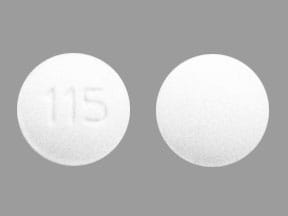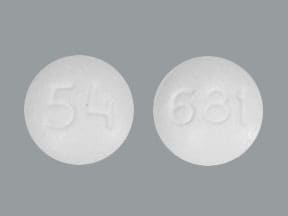Boxed Warning
Abuse potential:
Methamphetamine has a high potential for abuse. Particular attention should be paid to the possibility of subjects obtaining methamphetamine for nontherapeutic use or distribution to others, and the drug should be prescribed or dispensed sparingly. Misuse of methamphetamine may cause sudden death and serious cardiovascular adverse events.
Dosage Forms
Excipient information presented when available (limited, particularly for generics); consult specific product labeling.
Tablet, Oral, as hydrochloride:
Desoxyn: 5 mg [contains corn starch, sodium aminobenzoate]
Generic: 5 mg
Pharmacology
Mechanism of Action
A sympathomimetic amine related to ephedrine and amphetamine with CNS stimulant activity; causes release of catecholamines (primarily dopamine and other catecholamines) from their storage sites in the presynaptic nerve terminals. Inhibits reuptake and metabolism of catecholamines through inhibition of monoamine transporters and oxidase.
Pharmacokinetics/Pharmacodynamics
Absorption
Rapid from GI tract
Metabolism
Predominately hepatic via aromatic hydroxylation, N-dealkylation and deamination; forms ≥7 metabolites
Excretion
Urine primarily (dependent on urine pH; alkaline urine increases the half-life); ~62% of dose eliminated within first 24 hours as ~33% unchanged drug with remainder as metabolites
Half-Life Elimination
4 to 5 hours
Use: Labeled Indications
Attention-deficit/hyperactivity disorder (ADHD): For a stabilizing effect in children >6 years with a behavioral syndrome characterized by the following group of developmentally inappropriate symptoms: Moderate to severe distractibility, short attention span, hyperactivity, emotional lability, and impulsivity
Use: Off Label
Narcolepsycyes
Data from a limited number of patients in a double-blind, randomized crossover study suggests methamphetamine may be beneficial for the treatment of daytime sleepiness due to narcolepsy Mitler 1993. Additional trials may be necessary to further define the role of methamphetamine in this condition.
Based on the American Academy of Sleep Medicine practice parameters for the treatment of narcolepsy and other hypersomnias of central origin, methamphetamine is effective and suggested in the management of daytime sleepiness due to narcolepsy. Limited information regarding the benefit-to-risk ratio prevents methamphetamine from being classified as a standard therapy.
Contraindications
Hypersensitivity (eg, angioedema, anaphylaxis) to amphetamine or any component of the formulation; during or within 14 days following MAO inhibitors (including linezolid or methylene blue); glaucoma; advanced arteriosclerosis; symptomatic cardiovascular disease; moderate to severe hypertension; hyperthyroidism; hypersensitivity or idiosyncrasy to sympathomimetic amines; agitated state; patients with a history of drug abuse
Documentation of allergenic cross-reactivity for amphetamines is limited. However, because of similarities in chemical structure and/or pharmacologic actions, the possibility of cross-sensitivity cannot be ruled out with certainty.
Dosage and Administration
Dosing: Adult
Narcolepsy (off-label use): Oral: 20 to 60 mg administered within 1 hour of awakening (Mitler 1993). Additional data may be necessary to further define the role of methamphetamine in this condition.
Dosing: Geriatric
Refer to adult dosing; use with caution, starting at the lower end of the dosing range.
Dosing: Pediatric
Attention-deficit/hyperactivity disorder (ADHD): Note: Methamphetamine is not addressed in guidelines as a therapeutic option for treatment of ADHD; use has been replaced by other agents (AACAP [Pliszka 2007]; AAP 2011; NICE 2018). Use lowest effective individualized dose; administer first dose in early morning and avoid late evening administration:
Children ≥6 years and Adolescents: Oral: Initial: 5 mg once or twice daily; may increase by 5 mg increments in weekly intervals until optimum response is achieved; usual effective daily dose: 20 to 25 mg/day; dose may be divided twice daily.
Administration
Oral: Avoid late evening doses due to potential for insomnia.
Storage
Store at 20°C to 25°C (68°F to 77°F); protect from light.
Methamphetamine Images
Drug Interactions
Acebrophylline: May enhance the stimulatory effect of CNS Stimulants. Avoid combination
Alkalinizing Agents: May decrease the excretion of Amphetamines. Management: Consider alternatives to using amphetamines and alkalinizing agents in combination. If these agents must be used together, patients should be monitored closely for excessive amphetamine effects. Consider therapy modification
Amifampridine: Agents With Seizure Threshold Lowering Potential may enhance the neuroexcitatory and/or seizure-potentiating effect of Amifampridine. Monitor therapy
Ammonium Chloride: May decrease the serum concentration of Amphetamines. This effect is likely due to an enhanced excretion of amphetamines in the urine. Monitor therapy
Antacids: May decrease the excretion of Amphetamines. Monitor therapy
Antihistamines: Amphetamines may diminish the sedative effect of Antihistamines. Monitor therapy
Antihypertensive Agents: Amphetamines may diminish the antihypertensive effect of Antihypertensive Agents. Monitor therapy
Antipsychotic Agents: May diminish the stimulatory effect of Amphetamines. Monitor therapy
Ascorbic Acid: May decrease the serum concentration of Amphetamines. Monitor therapy
AtoMOXetine: May enhance the hypertensive effect of Sympathomimetics. AtoMOXetine may enhance the tachycardic effect of Sympathomimetics. Monitor therapy
BuPROPion: May enhance the neuroexcitatory and/or seizure-potentiating effect of Agents With Seizure Threshold Lowering Potential. Monitor therapy
Cannabinoid-Containing Products: May enhance the tachycardic effect of Sympathomimetics. Exceptions: Cannabidiol. Monitor therapy
Carbonic Anhydrase Inhibitors: May decrease the excretion of Amphetamines. Exceptions: Brinzolamide; Dorzolamide. Monitor therapy
Cocaine (Topical): May enhance the hypertensive effect of Sympathomimetics. Management: Consider alternatives to use of this combination when possible. Monitor closely for substantially increased blood pressure or heart rate and for any evidence of myocardial ischemia with concurrent use. Consider therapy modification
CYP2D6 Inhibitors (Moderate): May increase the serum concentration of Amphetamines. Monitor therapy
CYP2D6 Inhibitors (Strong): May increase the serum concentration of Amphetamines. Exceptions: FLUoxetine; PARoxetine. Monitor therapy
Doxofylline: Sympathomimetics may enhance the adverse/toxic effect of Doxofylline. Monitor therapy
Esketamine: May enhance the hypertensive effect of CNS Stimulants. Monitor therapy
Ethosuximide: Amphetamines may diminish the therapeutic effect of Ethosuximide. Amphetamines may decrease the serum concentration of Ethosuximide. Monitor therapy
Gastrointestinal Acidifying Agents: May decrease the serum concentration of Amphetamines. Monitor therapy
Guanethidine: May enhance the arrhythmogenic effect of Sympathomimetics. Guanethidine may enhance the hypertensive effect of Sympathomimetics. Monitor therapy
Iobenguane Radiopharmaceutical Products: Amphetamines may diminish the therapeutic effect of Iobenguane Radiopharmaceutical Products. Management: Discontinue all drugs that may inhibit or interfere with catecholamine transport or uptake for at least 5 biological half-lives before iobenguane administration. Do not administer these drugs until at least 7 days after each iobenguane dose. Avoid combination
Iobenguane Radiopharmaceutical Products: CNS Stimulants may diminish the therapeutic effect of Iobenguane Radiopharmaceutical Products. Management: Discontinue all drugs that may inhibit or interfere with catecholamine transport or uptake for at least 5 biological half-lives before iobenguane administration. Do not administer these drugs until at least 7 days after each iobenguane dose. Avoid combination
Ioflupane I 123: Amphetamines may diminish the diagnostic effect of Ioflupane I 123. Monitor therapy
Iohexol: Agents With Seizure Threshold Lowering Potential may enhance the adverse/toxic effect of Iohexol. Specifically, the risk for seizures may be increased. Management: Discontinue agents that may lower the seizure threshold 48 hours prior to intrathecal use of iohexol. Wait at least 24 hours after the procedure to resume such agents. In nonelective procedures, consider use of prophylactic anticonvulsants. Consider therapy modification
Iomeprol: Agents With Seizure Threshold Lowering Potential may enhance the adverse/toxic effect of Iomeprol. Specifically, the risk for seizures may be increased. Management: Discontinue agents that may lower the seizure threshold 48 hours prior to intrathecal use of iomeprol. Wait at least 24 hours after the procedure to resume such agents. In nonelective procedures, consider use of prophylactic anticonvulsants. Consider therapy modification
Iopamidol: Agents With Seizure Threshold Lowering Potential may enhance the adverse/toxic effect of Iopamidol. Specifically, the risk for seizures may be increased. Management: Discontinue agents that may lower the seizure threshold 48 hours prior to intrathecal use of iopamidol. Wait at least 24 hours after the procedure to resume such agents. In nonelective procedures, consider use of prophylactic anticonvulsants. Consider therapy modification
Methenamine: May decrease the serum concentration of Amphetamines. This effect is likely due to an enhanced excretion of amphetamines in the urine. Monitor therapy
Monoamine Oxidase Inhibitors: May enhance the hypertensive effect of Amphetamines. While linezolid and tedizolid may interact via this mechanism, management recommendations differ from other monoamine oxidase inhibitors. Refer to monographs specific to those agents for details. Avoid combination
Multivitamins/Fluoride (with ADE): May decrease the serum concentration of Amphetamines. More specifically, the ascorbic acid (vitamin C) in many multivitamins may decrease amphetamine concentrations. Monitor therapy
Multivitamins/Minerals (with ADEK, Folate, Iron): May decrease the serum concentration of Amphetamines. Monitor therapy
Multivitamins/Minerals (with AE, No Iron): May decrease the serum concentration of Amphetamines. Specifically, vitamin C may impair absorption of amphetamines. Monitor therapy
Opioid Agonists: Amphetamines may enhance the analgesic effect of Opioid Agonists. Monitor therapy
PHENobarbital: Amphetamines may decrease the serum concentration of PHENobarbital. Monitor therapy
Phenytoin: Amphetamines may decrease the serum concentration of Phenytoin. Monitor therapy
Quinolones: Amphetamines may enhance the cardiotoxic effect of Quinolones. Monitor therapy
Selective Serotonin Reuptake Inhibitors (Strong CYP2D6 Inhibitors): Amphetamines may enhance the serotonergic effect of Selective Serotonin Reuptake Inhibitors (Strong CYP2D6 Inhibitors). This could result in serotonin syndrome. Selective Serotonin Reuptake Inhibitors (Strong CYP2D6 Inhibitors) may increase the serum concentration of Amphetamines. Management: Monitor for increased amphetamine toxicities, including signs and symptoms of serotonin syndrome/serotonin toxicity (eg, hyperreflexia, clonus, hyperthermia, diaphoresis, tremor, autonomic instability) when these agents are combined. Monitor therapy
Serotonergic Agents (High Risk): Amphetamines may enhance the serotonergic effect of Serotonergic Agents (High Risk). This could result in serotonin syndrome. Management: Monitor for signs and symptoms of serotonin syndrome/serotonin toxicity (eg, hyperreflexia, clonus, hyperthermia, diaphoresis, tremor, autonomic instability, mental status changes) when these agents are combined. Exceptions: Amitriptyline; Amoxapine; ClomiPRAMINE; Desipramine; Dothiepin; Doxepin (Systemic); Doxepin (Topical); FLUoxetine; Imipramine; Isocarboxazid; Linezolid; Lofepramine; Melitracen [INT]; Methylene Blue; Moclobemide; Nortriptyline; PARoxetine; Phenelzine; Protriptyline; Tranylcypromine; Trimipramine. Monitor therapy
Solriamfetol: Sympathomimetics may enhance the hypertensive effect of Solriamfetol. Monitor therapy
Solriamfetol: CNS Stimulants may enhance the hypertensive effect of Solriamfetol. Monitor therapy
Sympathomimetics: May enhance the adverse/toxic effect of other Sympathomimetics. Monitor therapy
Tedizolid: May enhance the hypertensive effect of Sympathomimetics. Tedizolid may enhance the tachycardic effect of Sympathomimetics. Monitor therapy
Tricyclic Antidepressants: May enhance the adverse/toxic effect of Amphetamines. Tricyclic Antidepressants may potentiate the cardiovascular effects of Amphetamines. Amphetamines may enhance the serotonergic effect of Tricyclic Antidepressants. This could result in serotonin syndrome. Management: Monitor for signs and symptoms of serotonin syndrome/serotonin toxicity (eg, hyperreflexia, clonus, hyperthermia, diaphoresis, tremor, autonomic instability, mental status changes) and increased cardiovascular effects when these agents are combined. Monitor therapy
Urinary Acidifying Agents: May decrease the serum concentration of Amphetamines. Monitor therapy
Test Interactions
Amphetamines may elevate plasma corticosteroid levels; may interfere with urinary steroid determinations.
Adverse Reactions
Frequency not defined.
Cardiovascular: Hypertension, increased blood pressure, palpitations, tachycardia
Central nervous system: Dizziness, drug dependence (prolonged use), dysphoria, euphoria, exacerbation of tics (motor, phonic, and Tourette's syndrome), headache, insomnia, overstimulation, psychotic symptoms, restlessness
Dermatologic: Alopecia, urticaria
Endocrine & metabolic: Change in libido, growth suppression (children)
Gastrointestinal: Constipation, diarrhea, gastrointestinal distress, unpleasant taste, xerostomia
Genitourinary: Frequent erections, impotence, prolonged erection
Neuromuscular & skeletal: Rhabdomyolysis, tremor
Warnings/Precautions
Concerns related to adverse effects:
- Cardiovascular events: CNS stimulant treatment has been associated with sudden death in children and adolescents with preexisting structural cardiac abnormalities and sudden death, stroke, and MI have been reported in adults. Consistent with other studies, a large retrospective cohort study involving 1,200,438 children, adolescents, and young adults (aged 2 to 24 years) prescribed methylphenidate, dexmethylphenidate, dextroamphetamines, amphetamine salts, pemoline, or atomoxetine found no evidence that current use of an ADHD medication increased risk for sudden cardiac death, acute MI, or stroke (Cooper 2011). Stimulants should be avoided in patients with known structural cardiac abnormalities, cardiomyopathy, serious heart rhythm abnormalities, coronary artery disease, Marfan syndrome, or other serious cardiac problems. Some products are contraindicated in patients with moderate or severe hypertension, angina, heart failure, arrhythmias, or recent MI. Prior to initiating stimulant, assess medical history and family history of sudden death or ventricular arrhythmia; conduct a physical exam to assess for cardiac disease; patients should receive further evaluation if findings suggest cardiac disease, such as ECG and echocardiogram. Promptly conduct cardiac evaluation in patients who develop exertional chest pain, unexplained syncope, or any other symptoms of cardiac disease during stimulant treatment.
- CNS effects: Amphetamines may impair the ability to engage in potentially hazardous activities; patients must be cautioned about performing tasks which require mental alertness (eg, operating machinery or driving).
- Peripheral vasculopathy: Stimulants are associated with peripheral vasculopathy, including Raynaud phenomenon; signs/symptoms are usually mild and intermittent, and generally improve with dose reduction or discontinuation. Peripheral vasculopathy effects have been observed at different times, at therapeutic doses, and in all age groups. Digital ulceration and/or soft tissue breakdown have been observed rarely; monitor for digital changes during therapy and seek further evaluation (eg, rheumatology) if necessary.
- Visual disturbance: Difficulty in accommodation and blurred vision has been reported with the use of stimulants.
Disease-related concerns:
- Cardiovascular disorders: CNS stimulants may increase heart rate and blood pressure; in pediatric patients, the observed mean increase in heart rate was 3 to 6 bpm and blood pressure was 2 to 4 mm Hg. Use with caution in patients with hypertension, heart failure, recent MI, ventricular arrhythmia, and other cardiovascular conditions that might be exacerbated by increases in blood pressure or heart rate. Use is contraindicated in patients with moderate to severe hypertension or hyperthyroidism.
- Psychiatric disorders: Use with caution in patients with preexisting psychosis (may exacerbate symptoms of behavior and thought disorder) or bipolar disorder (may induce mixed/manic episode). New-onset psychosis or mania may occur with stimulant use. Patients should be screened for bipolar disorder and risk factors for developing a manic episode prior to treatment; consider discontinuation if psychotic or manic symptoms (eg, delusional thinking, hallucinations, or mania) occur. May be associated with aggressive behavior or hostility (causal relationship not established); monitor for development or worsening of these behaviors.
- Seizure disorder: Limited information exists regarding stimulant use in seizure disorder. Whereas patients with ADHD are at an increased risk for seizure activity compared to the general population, a retrospective study using drug claims data showed that the use of stimulant medications was associated with a lower risk (Cortese 2013; Wiggs 2018). Manufacturers of some stimulants recommend discontinuing therapy if seizures occur.
- Tourette syndrome/tics: Use with caution in patients with Tourette syndrome or other tic disorders. Stimulants may exacerbate tics (motor and phonic) and Tourette syndrome; however, evidence demonstrating increased tics is limited. Evaluate for tics and Tourette syndrome prior to therapy initiation (AACAP [Murphy 2013; Pliszka 2007]).
Concurrent drug therapy issues:
- Drug-drug interactions: Potentially significant interactions may exist, requiring dose or frequency adjustment, additional monitoring, and/or selection of alternative therapy. Consult drug interactions database for more detailed information.
- Serotonin syndrome: Potentially life-threatening serotonin syndrome (SS) may occur when methamphetamine is used in combination with other serotonergic agents (eg, selective serotonin reuptake inhibitors, serotonin norepinephrine reuptake inhibitors, triptans, tricyclic antidepressants, fentanyl, lithium, tramadol, buspirone, St. John's wort, tryptophan), agents that impair metabolism of serotonin (eg, monoamine oxidase inhibitors) or CYP2D6 inhibitors that impair metabolism of methamphetamine. Concomitant use with monoamine oxidase inhibitors is contraindicated. If concomitant use of methamphetamine with serotonergic drugs or CYP2D6 inhibitors is indicated, initiate methamphetamine at a low dose and monitor patient closely for signs and symptoms of SS. Discontinue treatment (and any concomitant serotonergic agent) immediately if signs/symptoms arise.
Special populations:
- Elderly: Use caution in this age group due to CNS stimulant adverse effects.
- Pediatric: Appetite suppression may occur, particularly in children. Use of stimulants has been associated with weight loss and slowing growth rate; monitor growth rate and weight during treatment. ADHD treatment interruption may be necessary in patients who are not increasing in height or gaining weight as expected.
Other warnings/precautions:
- Abuse/misuse/diversion: [US Boxed Warning]: Has high potential for abuse. Particular attention should be paid to the possibility of subjects obtaining methamphetamine for nontherapeutic use or distribution to others, and the drug should be prescribed or dispensed sparingly. Misuse of methamphetamine may cause sudden death and serious cardiovascular adverse events.
- ADHD treatment: Appropriate use: Recommended to be used as part of a comprehensive treatment program for attention deficit disorders.
- Discontinuation of therapy: Abrupt discontinuation following high doses for prolonged periods results in extreme fatigue, mental depression, and sleep EEG changes; may also result in other symptoms of withdrawal.
- Inappropriate use: Therapy is not appropriate for the treatment of fatigue or to replace rest in normal patients.
Monitoring Parameters
Cardiac evaluation should be completed at baseline and on any patient who develops exertional chest pain, unexplained syncope, and any symptom of cardiac disease during treatment with stimulants. Monitor blood pressure and heart rate (baseline, following dose increases and periodically during treatment); growth rate (height and weight) and appetite in children; weight in adults; signs of peripheral vasculopathy (eg, digital changes); sleep and behavioral changes. Assess for risk of abuse prior to prescribing and signs of misuse, abuse, or addiction throughout treatment (NICE 2018).
Pregnancy
Pregnancy Risk Factor
C
Pregnancy Considerations
Adverse events have been observed in animal reproduction studies. Methamphetamine and amphetamine were detected in newborn tissues following intermittent maternal use of Desoxyn during pregnancy (Garriott 1973). The majority of human data is based on illicit amphetamine/methamphetamine exposure and not from therapeutic maternal use (Golub 2005). Use of amphetamines during pregnancy may lead to an increased risk of premature birth and low birth weight; newborns may experience symptoms of withdrawal. Behavioral problems may also occur later in childhood (LaGasse 2012).
Patient Education
- Discuss specific use of drug and side effects with patient as it relates to treatment. (HCAHPS: During this hospital stay, were you given any medicine that you had not taken before? Before giving you any new medicine, how often did hospital staff tell you what the medicine was for? How often did hospital staff describe possible side effects in a way you could understand?)
- Patient may experience dry mouth, trouble sleeping, constipation, diarrhea, anxiety, bad taste, lack of appetite, nausea, hair loss, or weight loss. Have patient report immediately to prescriber signs of severe cerebrovascular disease (change in strength on one side is greater than the other, trouble speaking or thinking, change in balance, or change in eyesight), chest pain, shortness of breath, severe dizziness, passing out, vision changes, fast heartbeat, slow heartbeat, abnormal heartbeat, tremors, agitation, severe headache, sexual dysfunction, decreased sex drive, erection that lasts more than 4 hours, signs of serotonin syndrome (dizziness, severe headache, agitation, sensing things that seem real but are not, fast heartbeat, abnormal heartbeat, flushing, tremors, sweating a lot, change in balance, severe nausea, or severe diarrhea), seizures, change in color of hands or feet from opale to blue or red, burning or numbness of hands or feet, cold sensation of extremities, painful extremities, wounds on fingers or toes, dark urine, unable to pass urine, muscle pain, muscle weakness, mood changes, sensing things that seem real but are not, behavioral changes, or signs of depression (thoughts of suicide, anxiety, emotional instability, illogical thinking) (HCAHPS).
- Educate patient about signs of a significant reaction (eg, wheezing; chest tightness; fever; itching; bad cough; blue skin color; seizures; or swelling of face, lips, tongue, or throat). Note: This is not a comprehensive list of all side effects. Patient should consult prescriber for additional questions.
Intended Use and Disclaimer: Should not be printed and given to patients. This information is intended to serve as a concise initial reference for health care professionals to use when discussing medications with a patient. You must ultimately rely on your own discretion, experience, and judgment in diagnosing, treating, and advising patients.






